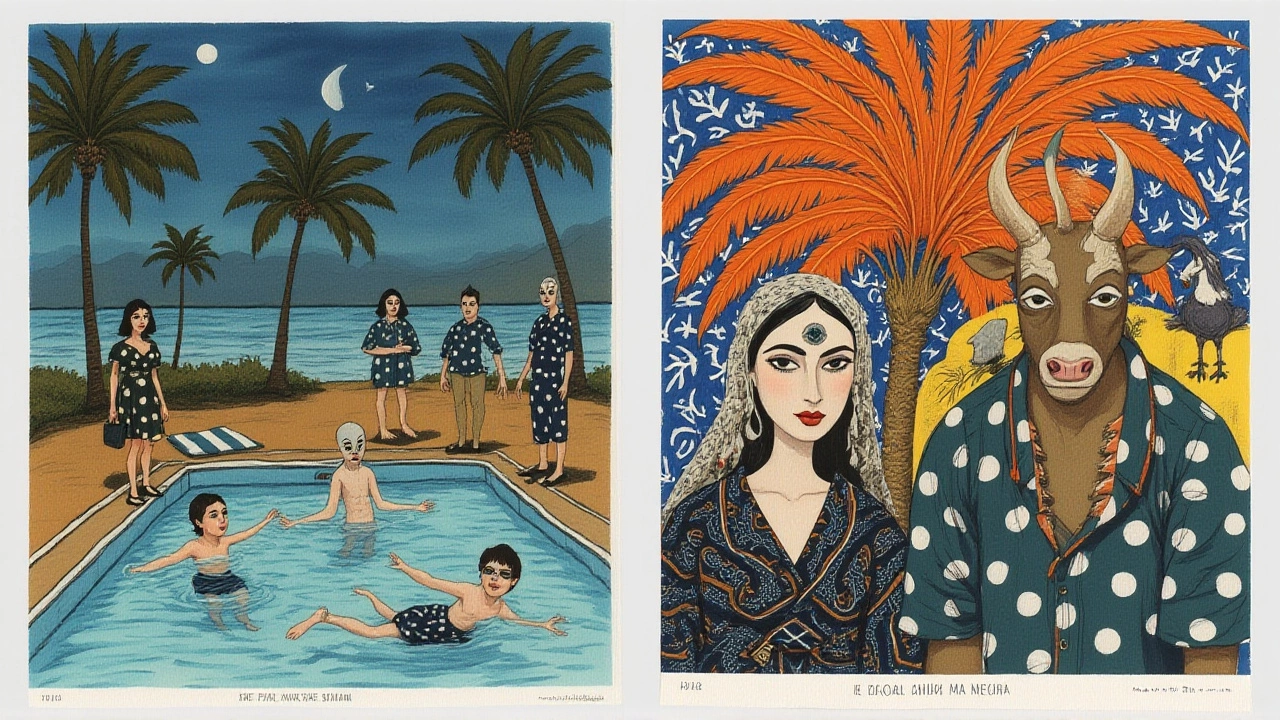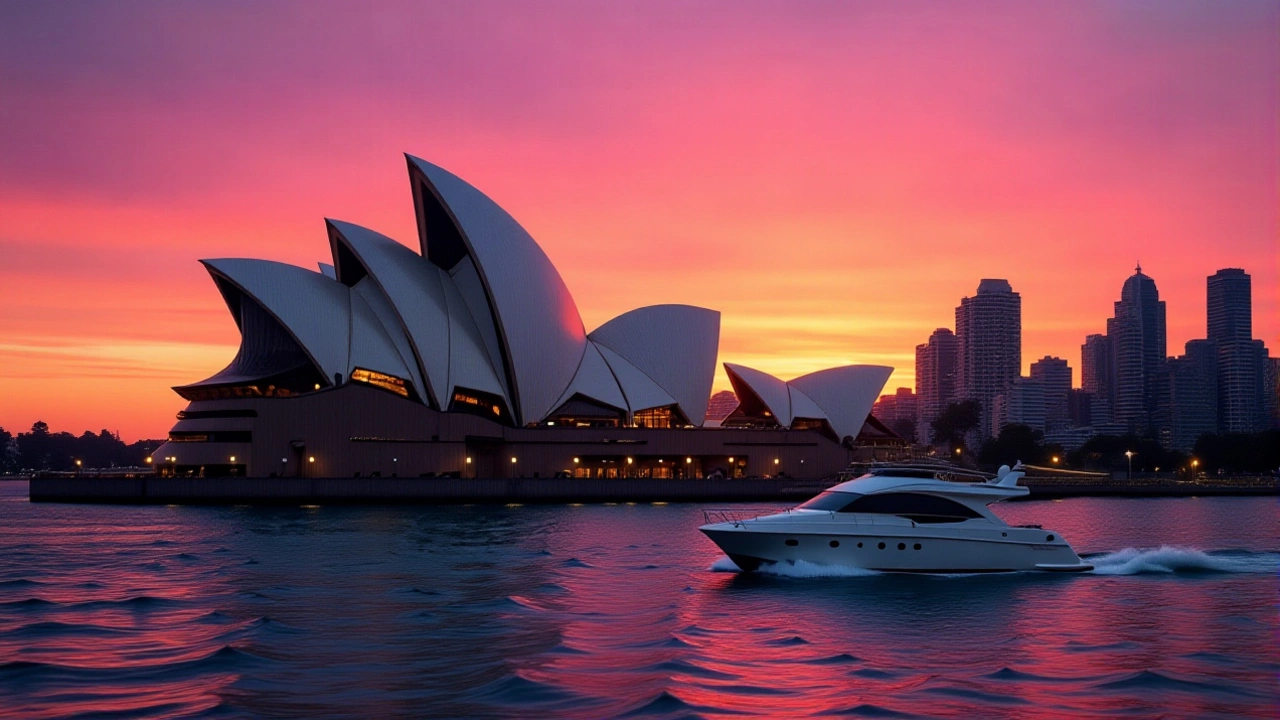Marcel Dzama’s Morocco‑Inspired Color Shift Shines in “Who Loves the Sun” Exhibition
 Oct, 5 2025
Oct, 5 2025
When Marcel Dzama returned from a four‑week family trek through Morocco in 2018, his studio in Brooklyn emptied of the gritty, politically‑charged sketches that had marked the previous decade.
The Canadian artist, who lives with his wife and son in Brooklyn, says the trip was a lifeline. "I was exhausted by the constant outrage," he told a reporter, "and the moon over Essaouira reminded me there’s still wonder in the world." That night‑time walk with his son, under a moon the size of a lantern, became a recurring visual motif.
From Dark Allegories to Bright Vignettes
Before 2018, Dzama’s canvases were dominated by macabre battles, decapitated figures and masked dancers brandishing weapons – a visual diary of a world he felt increasingly alienated from. By the time he set foot in the Atlas Mountains, the palette of his sketches had already begun to lighten, coaxed by the turquoise tiles of Marrakesh souks and the ochre tones of the desert horizon.
His later series, first shown online under the title Pink Moon, employed pastel pinks and saturated blues to echo the desert night sky. The exhibition, hosted by David Zwirner gallery, was paired with a limited‑edition travel book from Louis Vuitton, underscoring the commercial appeal of wanderlust‑driven art.
Travel as a Creative Reset
Dzama’s itinerary read like a travel‑blog checklist: Tangier, Marrakesh, Fes, Casablanca, and a night‑long hike in the Atlas. Each stop contributed a color, a texture, a sound that later surfaced in his drawings of tropical birds, sun‑splashed dunes, and street musicians.
“The markets were a riot of pattern,” Dzama recalled. “I started sketching textile designs instead of protest slogans.” He also spent time in Mexico before the pandemic, where the lush greenery and vibrant street art further nudged his hand toward optimism.
The “Who Loves the Sun” Exhibition
From September 1 to October 31, 2025, the Who Loves the Sun show unfolded in New York at David Zwirner’s 69th Street space. The title, lifted from a Velvet Underground lyric, hinted at the exhibition’s core ambition: to celebrate light after a two‑year global lockdown.
Visitors encountered a blend of media – small oil paintings, etchings, and large‑format prints – each threaded with references to the artist’s photographs taken in Morocco, Mexico, and even Fire Island. A recurring figure—a masked, winged creature dancing under a phosphorescent moon—served as a bridge between his earlier, darker mythologies and the newfound optimism.
One of the most talked‑about pieces, "Moon Over Essaouira," features the huge lunar disc rendered in luminous pink, flanked by a boy in a red scarf (a nod to Dzama’s son). Critics noted how the work “captures a moment of private wonder made public,” a sentiment echoed by curator Katherine Hargreaves in the gallery press release.
Reactions From the Art World
Reviews have been largely upbeat. The New York Times praised the shift, writing, “Dzama’s recent palette feels like a sunrise after a storm.” Meanwhile, some longtime fans miss the visceral edge of his earlier war‑scenes, arguing that the bright hues risk diluting his political voice.
Dzama himself defends the change: “I’m not abandoning critique; I’m choosing a different language. Color can be as confrontational as a clenched fist.” He added that the pandemic’s isolation made “visual hope” an essential service for audiences scrolling through screens.

What This Means for Contemporary Art
The pivot underscores a broader trend: artists who weathered the 2020 lockdown are emerging with more hopeful, escapist aesthetics. Galleries, eager to re‑ignite foot traffic, are showcasing work that offers a mental vacation – a strategy that aligns with the resurgence of travel‑related merchandising (think the Louis Vuitton book tied to Dzama’s project).
In practical terms, the market has responded. Primary‑sale prices for Dzama’s post‑2018 pieces have risen 27 % on average, according to auction data from Christie’s. Collectors are especially drawn to limited‑edition prints from the “Pink Moon” series, which have sold out within weeks of release.
Looking Ahead
Dzama hints at a new body of work inspired by forthcoming trips to Japan and the Scottish Highlands. If the pattern holds, expect another splash of unexpected colour and perhaps a fresh mythological mash‑up.
For now, the artist remains in Brooklyn, still photographing street scenes and sketching whenever his son asks for a new moon drawing. "Travel is a reminder that we exist beyond our frustrations," he says, "and that’s exactly the lens I want to keep using."
Frequently Asked Questions
How has the Morocco trip changed Dzama’s artistic style?
The journey introduced a burst of vivid pigments and softer subject matter. Dzama swapped blood‑red battle scenes for pastel moons, turquoise markets and sun‑lit deserts, signaling a move toward hope rather than outrage.
What are the key works featured in the “Who Loves the Sun” show?
Highlights include “Moon Over Essaouira,” a pink‑hued lunar portrait; a series of small oil paintings titled “Desert Lullabies” that draw on Atlas Mountain textures; and the “Pink Moon” prints that marry Moroccan patterns with Mexican flora.
Why did Dzama collaborate with Louis Vuitton for a travel book?
Louis Vuitton’s travel‑book line celebrates global wanderlust, mirroring Dzama’s own narrative of escape and inspiration. The partnership amplified the exhibition’s reach, offering readers a tactile companion to the online “Pink Moon” showcase.
Who is the target audience for Dzama’s new, brighter work?
Beyond existing collectors, the vibrant imagery appeals to a post‑pandemic public craving visual optimism. Galleries report higher foot traffic from younger visitors who connect the travel‑inspired motifs with their own social‑media‑driven desire for escapism.
What might we expect from Dzama’s upcoming projects?
Hints of future trips to Japan and Scotland suggest new palettes – perhaps indigo blues and misty greys – blended with his signature fantastical figures. Fans anticipate a continuation of the hopeful tone, enriched by fresh cultural symbols.
